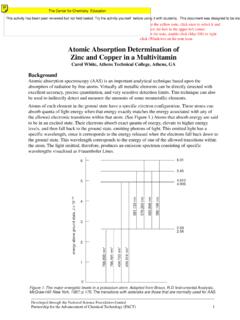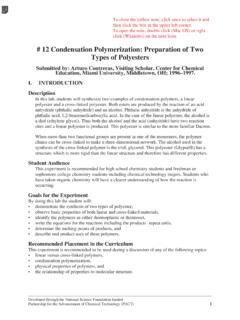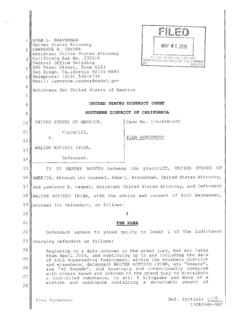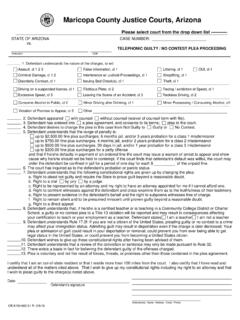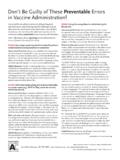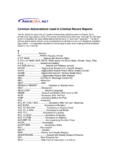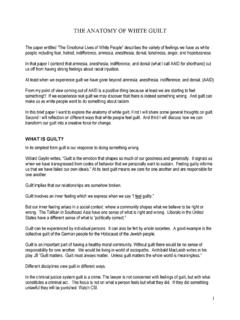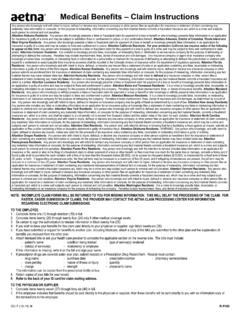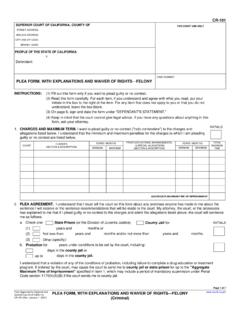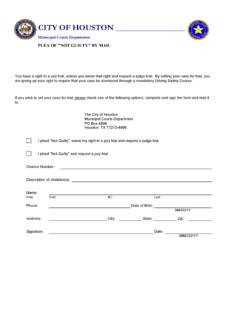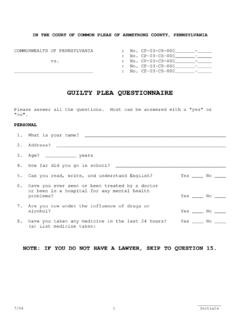Transcription of innocent or guilty - Terrific Science
1 Developed through the National Science Foundation-fundedPartnership for the Advancement of Chemical Technology (PACT)1 innocent or guilty : A Lab on DNA Gel ElectrophoresisJoAnn Smith, California Studio Teacher, North Hills, CAINTRODUCTIOND escriptionThis lesson, based on EDVOTEK Kit #109, DNA Fingerprinting I: Identification of DNA byRestriction Fragmentation Patterns, presents a simulation of a DNA fingerprint (RFLP RestrictionFragment Length Polymorphism).The prelab section introduces the importance of DNA fingerprinting a form of identification that isbeing accepted by both scientific and legal experts.
2 The procedure is used in forensic work, paternitysuits, missing-person cases, archeology, and animal breeding. The protocol for the lab is lab involves students preparing a gel for electrophoresis. DNA fragments, which have beenpredigested using two different restriction enzymes, will be run on a gel electrophoresis apparatus,and the results will be analyzed to determine which suspect committed the post-lab section concentrates on the ethical implications of DNA AudienceThis lesson is appropriate for average to gifted students, grades 8 for the ActivityThe goals of this activity are to introduce students to agarose gel electrophoresis as a tool for separating DNA fragments, introduce the concept of DNA fingerprinting.
3 Give students practice in interpreting results, enable students to discuss the ethics of the procedure through reading and class discussion, allow students to identify personal values and understand the relationship between these valuesand ethical choices, help students understand the role of philosophical and ethical concerns and their relationship tobiotechnology, and help students recognize and respect opposing Placement in the CurriculumThis lesson would be appropriate as a culminating activity for a unit on human genetics, molecularbiology, or microbial close the yellow note, click once to select it andthen click the box in the upper left open the note, double click (Mac OS) or rightclick (Windows) on the note through the National Science Foundation-fundedPartnership for the Advancement of Chemical Technology (PACT)2 STUDENT HANDOUTI nnocent or guilty : A Lab on DNA Gel ElectrophoresisScenario/Industrial ApplicationA newspaper account of a crime scene may be used, or a scenario such as the following may be used.
4 Sixteen-year-old Michele Michael, a popular honor student and cheerleader, has been foundmurdered. She was reported missing by her family almost a year ago, and her decomposed bodyhas been discovered in the desert by a police, after an extensive investigation, have narrowed the list of possible suspects to twopeople. Bonita Ballantine, an older half-sister of Michele s, has a history of rivalry with was seen in public arguing with Michele about one week before her her jealousy of Michele was well known, Bonita denies that she had anything to dowith Michele s disappearance and Chadwick, Michele s ex-boyfriend, also denies having anything to do with Michele sdisappearance and murder.
5 However, Michele complained to a friend about two months after herbreakup with Brad that she had seen him following her. She was growing increasinglyuncomfortable with Brad s obsessive attention and planned to get a restraining order against s friend has given him an alibi for the night Michele disappeared, but police feel he is still aprime not belonging to the victim was found at the crime scene. Blood samples have been takenfrom each of the suspects. You are going analyze these samples (using a procedure similar tothose used at actual forensic labs)
6 And decide whether either of the suspects is the included in the EDVOTEK DNA Fingerprinting I Kit #109 DNA sample from crime scene cut with Enzyme 1 DNA sample from crime scene cut with Enzyme 2 DNA sample from Suspect 1 cut with Enzyme 1 DNA sample from Suspect 1 cut with Enzyme 2 DNA sample from Suspect 2 cut with Enzyme 1 DNA sample from Suspect 2 cut with Enzyme 2 tube of practice gel loading solution bottle of UltraSpec-Agarose powder bottle of 50X concentrated electrophoresis buffer bottle of concentrated Methylene Blue Plus stain 10-mL pipet 100-mL graduated cylinder microtipped transfer pipetsOther materials horizontal gel electrophoresis apparatus DC power supply automatic micropipets and tips water bath (65 C) staining tray and netCollection of Laboratory Activities: innocent or guilty .
7 A Lab on DNA Gel ElectrophoresisDeveloped through the National Science Foundation-fundedPartnership for the Advancement of Chemical Technology (PACT)3 fluorescent light box or overhead projector microwave, hot plate, or burner pipet pumps or bulbs 250-mL flasks or beakers vinyl gloves and safety goggles aprons distilled or deionized water small plastic containers with covers or zipper-type plastic bags permanent marking pens Styrofoam containers and ice plastic wrap (optional) microcentrifuge (optional) cameraSafety, Handling, and DisposalIt is your responsibility to specifically follow your institution s standard operating procedures(SOPs) and all local, state, and national guidelines on safe handling and storage of all chemicals andequipment you may use in this activity.
8 This includes determining and using the appropriate personalprotective equipment ( , goggles, gloves, apron). If you are at any time unsure about an SOP orother regulation, check with your dealing with biological materials, take particular precautions as called for by the kitmanufacturer or methylene blue is relatively harmless, it will stain clothes, skin, and other surfaces. Aprons,gloves, and goggles should be of used reagents according to local analysis in a forensic lab proceeds as follows: The first step is to extract high-molecular-weight, duplex DNA from blood, semen, skin, or hair roots.
9 This step is followed by enzymes are then used to digest the DNA. Agarose gel electrophoresis is performed toseparate the DNA fragments according to size. This is the procedure you will be performing duringthis lab, which uses predigested samples of nonhuman of the DNA separates the strands of the double helix. A Southern Blot transfers theresults to a nylon or nitrocellulose filter. A radioactively labeled probe is added. It will hybridize tothe complementary DNA so that the results can be exposed to X-ray film and be detected for performing the agarose gel electrophoresis1.
10 Pour agarose gel into the gel bed (if this step has not been performed by instructor).2. After it sets, place agarose gel in the gel bed into an electrophoresis gel of Laboratory Activities: innocent or guilty : A Lab on DNA Gel ElectrophoresisDeveloped through the National Science Foundation-fundedPartnership for the Advancement of Chemical Technology (PACT)43. Add electrophoresis buffer to the gel apparatus until the gel is just With a clean pipet, place 5 L of #1 DNA cut with enzyme #1 into well #1 of agarose With a clean pipet, place 5 L of #1 DNA cut with enzyme #2 into well # With a clean pipet, place 5 L of #2 DNA cut with enzyme #1 into well # With a clean pipet, place 5 L of #2 DNA cut with enzyme #2 into well # With a clean pipet, place 5 L of crime scene DNA cut with enzyme #1 into well # With a clean pipet.


